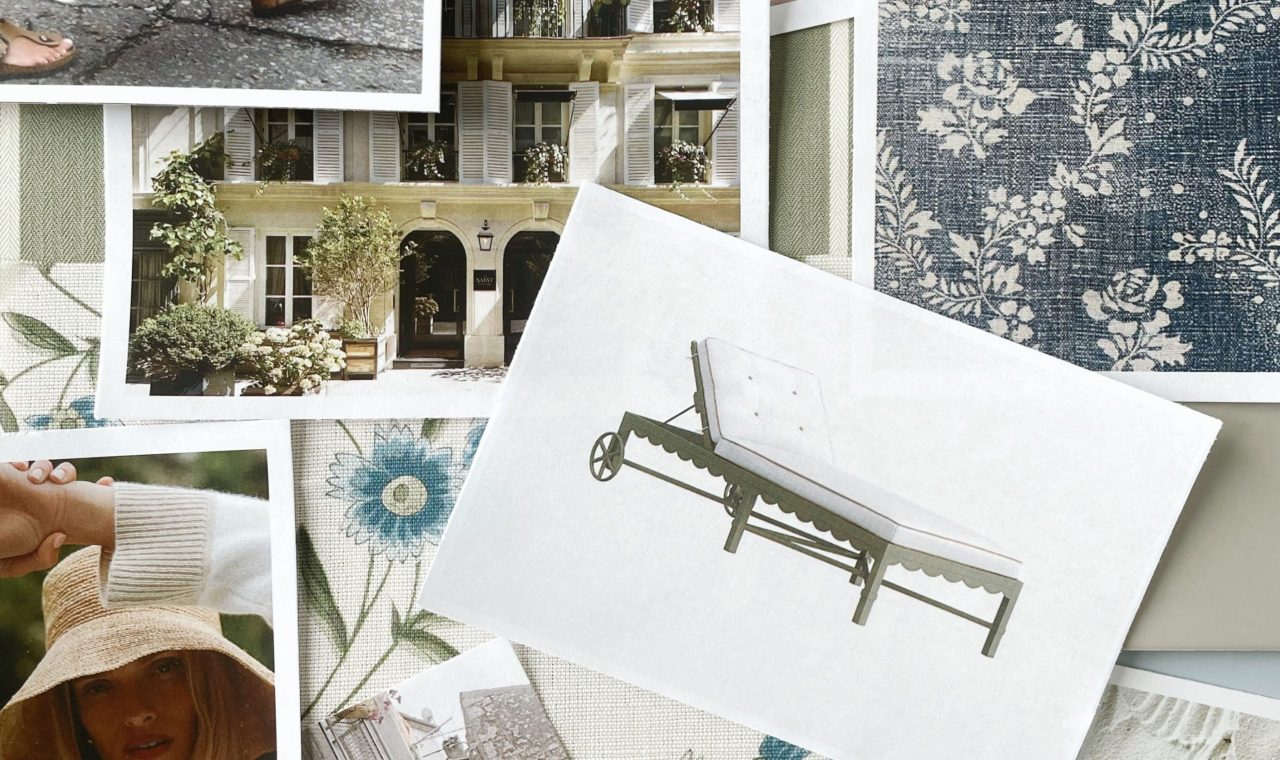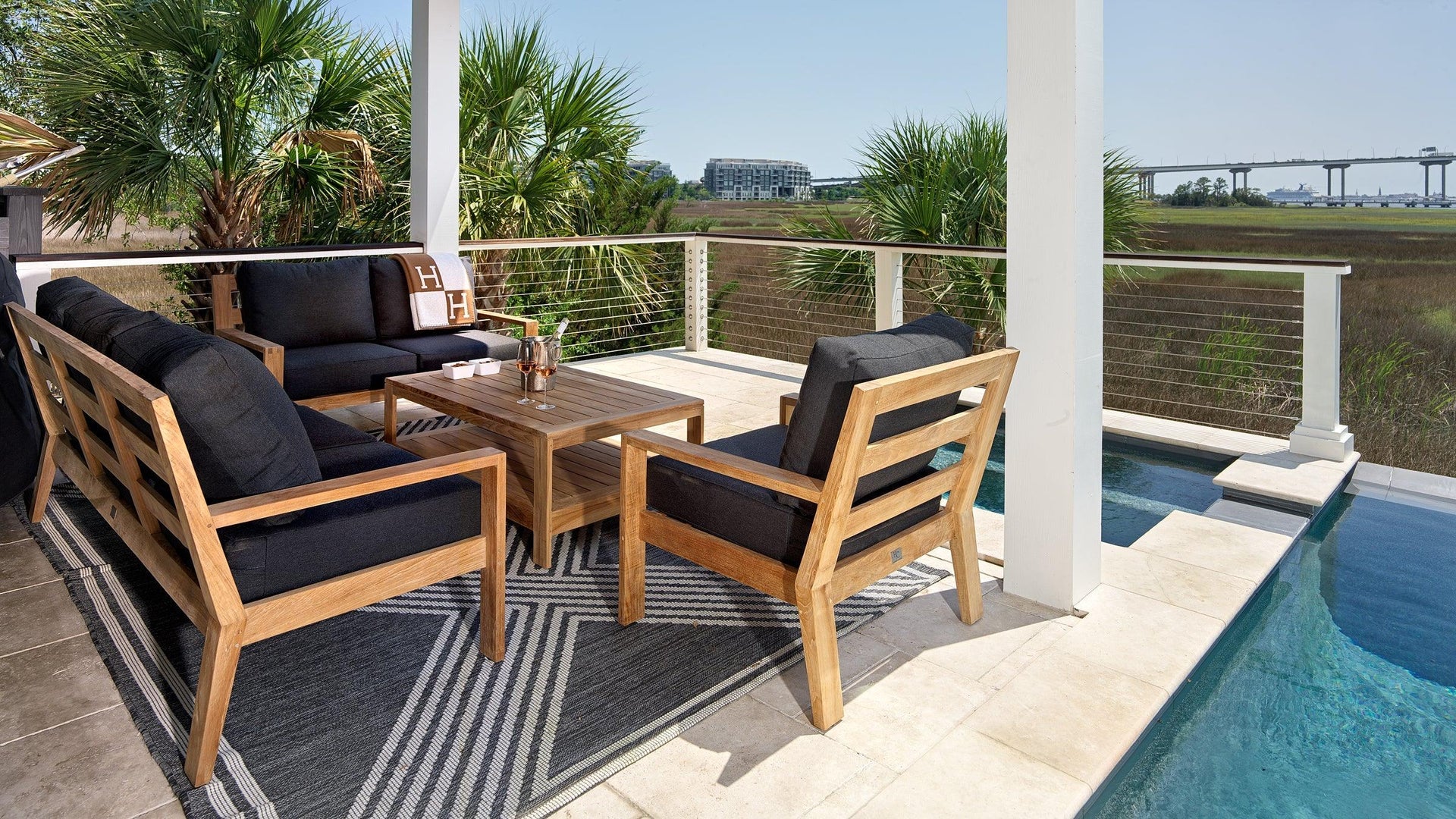As you sit on your patio sipping your lemonade, you notice the sun disappear behind the clouds and feel a few drops of rain land on your forehead. Fortunately, Sunbrella fabrics, which can provide canopy protection or be upholstered to outdoor furniture—can keep you and your furniture dry when the sky becomes gray and soggy.
That’s all due to Sunbrella's fabric.
When it comes to outdoor patio furniture, durability isn’t an option; it’s a necessity. A Sunbrella’s acrylic fabric is waterproof, fast-drying, and UV resistant to protect outdoor furniture in humid and rain-prone climates. This guide covers everything you need to know about this versatile and durable outdoor textile.
What Is Sunbrella Fabric Made Of?
What is Sunbrella fabric made of, and what properties does it have? Sunbrella fabric is a solution-dyed colored canvas. The canvas is made from acrylic fiber, a synthetic or man-made material. Synthetics are lab creations that combine polymers, a chemical compound of long molecule chains.
The key is that acrylic fabric is:
- Waterproof
- Fast-drying
- UV resistant
In its lab form, however, acrylic fiber is an unstable material, existing in a state of flux between gas and solid. In this state, the dye can be added to the mixture, allowing colors to saturate the fibers. This solution-dye process gives Sunbrella’s fabrics extra color fade resistance.
As a finishing touch, the fabric is treated with a fluorocarbon finish, filling in any pores and ensuring waterproof qualities. For some water-resistant context, sailors originally wore canvas covered in oils to withstand storm and rain conditions out at sea! It’s why Sunbrella fabrics are the best fabric for outdoor furniture.
Sustainability
Sunbrella’s upholstery fabrics have been tested for harmful substances and certified as STANDARD 100 by OEKO-TEX, a sustainable furnishing council developed by leading Australian and German textile research institutes. STANDARD 100 is the global group’s highest benchmark.
In addition, Sunbrella was also certified by the Greenguard Environmental Institute (GEI) as a product with a low-emission rating.
Since 2020, some Sunbrella fabrics have been produced fluorine-free, without the fluorocarbon finish. A sustainable solution, the fabrics feature a new bio-based formula that creates the same levels of water resistance during the solution-dye process.
Can Sunbrella Fabric Be Left in the Rain?
Reading a foreboding forecast before heading out the door? Snuggle up inside and stay confident in fabrics engineered for the unexpected. You can avoid the rush before the thunder and trust your outdoor fabrics to stand up to any downpour with Sunbrella.
So, is sunbrella fabric waterproof? Somewhat.
While most fabrics absorb rainwater, the threads in Sunbrella fabric expand when they come in contact with liquid. Of course, this process isn’t just true for rain. Snow also passes the test! If you’re located in climates like New England or Montana, you can consider a new snow day picnic tradition with Sunbrella.
The same qualities that allow Sunbrella fabric to sing through the rain also prevent the material from absorbing dirt and debris that may accompany some rough weather. Simply wipe away loose residue after a storm’s rolled past.
How Long Does Sunbrella Fabric Last Outside?
On average, Sunbrella fabrics are designed to last five to ten years. However, if consistently cared for, fabrics may endure even longer. Sunbrella’s outdoor durability is due to design technology that can mitigate and prevent:
- Chemicals and pollutants – The fabric’s synthetic acrylic fiber is designed with minimal to no pores. Therefore, you can clean your Sunbrella fabrics with bleach and other cleaning products, which won’t adhere to or be absorbed by the material.
- Color fading – The solution-dye method means the fabric fibers are saturated in UV-stabilized pigments that become inherent to the threads’ makeup. A study cited by Sunbrella noted that when subject to 1500 hours of high radiation, the fabrics exhibited minimal to no color change.
- Mildew formation – Similar to chemical and pollutant resistance, the tight fibers allow little to no space for mildew spores to thrive and multiply.
- Stains – Stains typically occur due to chemical reactions or instant absorption. Sunbrella is resistant to acids and alkalis, substances often found in wine, coffee, food items, and other solvents that can cause staining on average fabrics.
Climate note: Most Sunbrella fabrics are not fire resistant, so consider the necessary precautions if you live in a high-risk area like California or Colorado or plan to keep your furniture around an open fire pit.
What Climates Can Sunbrella Fabric Support?
Across the board, Sunbrella’s fabric checks all the boxes regarding global climate considerations. Make sure to consider the material of the furniture you’re covering in Sunbrella fabric, as you’ll want to ensure that the framing can withstand certain temperaments, too.
Match your materials to your local conditions with these top tips:
- Cold – Pair Sunbrella fabric with a rust-proof material design to brave snow or icy conditions. Sunbrella will resist melting runoff while the rust-proof frame shines through blizzards.
- Mild – Mix Sunbrella’s woven wonder with a unique wicker form and sink into any comfortably cool climate.
- Hot – Aluminum is a no-fuss metal blend, and when paired with Sunbrella’s UV-resistant threads, this duo can be content sunning by the pool for months on end.
- Humid – Add this trusted fabric to synthetic teak, a material once used in boats, for smooth sailing through any seasonal storm. It’s mold- and mildew-free.
What Is Waterproof Fabric?
Waterproof refers to materials that resist water absorption or penetration by water molecules. The idea of “waterproof” was brought to the attention of Western material science by Charles Macintosh, an American chemist who combined heated coal with natural rubber.
A few decades later, another scientist, Thomas Burberry, of the famed London brand, found that tightly woven fabric could exhibit the same waterproof properties. As chemistry and technology advanced, twentieth-century fashion exploded with designs created with man-made, plastic fabrics.
Sunbrella began in the same century as the flagship manufacturer of outdoor awnings. Searching for a weather-resistant compromise for the common cotton alternative on the market, Sunbrella’s founders turned to molecular science to develop a durable fabric down to its chemical components.
Waterproof vs. Water Repellant
Waterproof can often be confused with the term water repellant. Note these quick definitions and subtle differences:
- Waterproof – Waterproof refers to material that resists or withstands water molecules. Often this means fabrics are treated with specific chemicals, or threads are closely woven to eliminate pores. Think of your favorite rubber rain boots or a plastic umbrella.
- Water Repellent – Repellent signifies that material resists wetting; however, pores still allow water or vapor to permeate. Picture workout clothing or outerwear like a windbreaker. Comfort often means sacrificing impermeability for breathability.
To claim waterproof status, materials must be tested in accordance with specific, government-sanctioned standards.
How Can I Protect My Fabrics Outdoors?
If you’re planning to be away for an extended period, storing your furniture somewhere covered never hurts. When it comes to your day-to-day activities, however, durable fabrics can protect your outdoor items.
Unless you’re in a particularly rough climate area, you should only have to care for your fabric every couple of months or so. However, you can save a trip to the store with Sunbrella fabric. Sunbrella’s resistant technology is safe from most cleaning products.
To clean outdoor upholstery, particularly dirt, refer to Sunbrella’s general instructions:
- Blot spills or debris with a dry cloth.
- Spray a mixture of water and mild soap or detergent onto the area.
- Rinse the fabric to remove the soap.
- Let your fabric air dry.
Mold & Mildew
Mold and mildew spores tend to form in damp conditions, traveling through open airways and slowly destroying the materials they land on. FEMA details that spores tend to form on surfaces in over forty percent humidity.
Sunbrella upholstery fabric is specifically designed to remain resistant to mold and mildew. However, spores can form on top if foreign substances like spills or dirt are not removed. Thankfully, the fabric’s lack of pores means cleaning is still possible.
Here are Sunbrella’s quick tips for mold clean-up:
- Mix one cup of bleach with ¼ cup of mild soap in a gallon of water.
- Spray the solution on the mold or mildew area and let it soak for at least 15 minutes.
- Use a towel or sponge to wipe and clean the area.
- Rinse out the soap with water.
- Let the fabric air dry.
Trust Your Fabrics to HC Luxury Outdoor
No matter the climate, your outdoor space can be a haven. Investing in reliable furniture and outdoor fabrics is central to enjoying pastimes within your home and to those memories waiting to be made in and around your property.
Making durable, stain-resistant qualities a priority, HC Luxury Outdoor uses Sunbrella’s outdoor performance fabric to fashion its line of timeless and naturally weather-resistant collections. Our partnership with Sunbrella means our outdoor furniture engages with the long-verified history of a revolutionary and leading fabric performer.
By combining heirloom quality construction with fabrics engineered to last, HC Luxury Outdoor allows you to enjoy your spaces without the hassle of constant care. Expand your office to the backyard love seat, or settle into a sustainable design with a good book in your downtime.
Open an umbrella and trust HC Luxury Outdoor to shepherd you through the eye of any storm.
Sources:
V&A. A very brief history of staying dry. https://www.vam.ac.uk/blog/textiles-and-fashion/a-very-brief-history-of-staying-dry
Sustainable Furnishings. OEKO-TEX, Sustainable Furnishings Council. https://sustainablefurnishings.org/oeko-tex?gclid=Cj0KCQjwj7CZBhDHARIsAPPWv3d-JI4NmXcrkq-eYklPtrd0jmyaYApFC-VNgwsYWp2lTlHQ4X7ZUlMaAvHBEALw_wcB
Sunbrella. Sunbrella Fabric Difference. https://www.sunbrella.com/sunbrella-fabric-difference
FEMA. Dealing with Mold & Mildew in Your Flood Damaged Home. https://www.fema.gov/pdf/rebuild/recover/fema_mold_brochure_english.pdf
PRN Newswire. Sunbrella Debus Eco-Friendly, Fluorine-Free Fabric. https://www.prnewswire.com/news-releases/sunbrella-debuts-eco-friendly-fluorine-free-fabric-301082562.html



